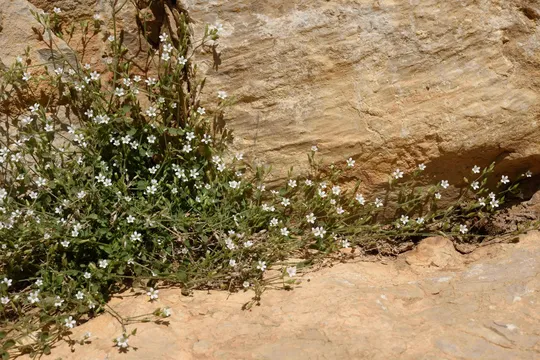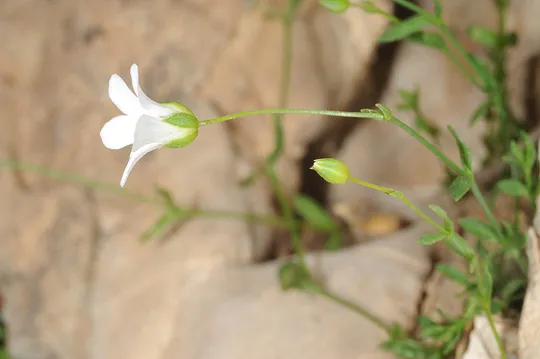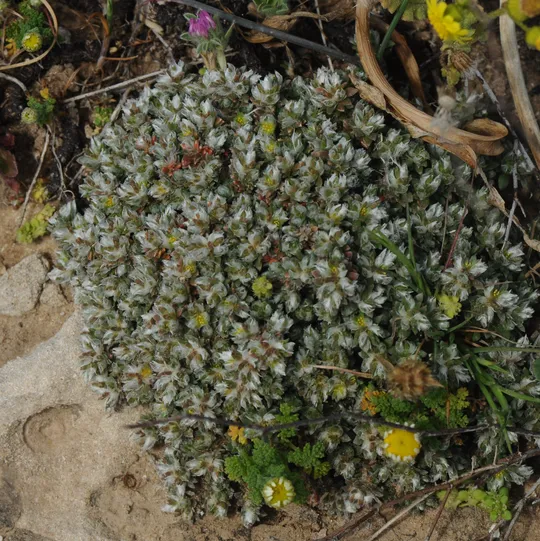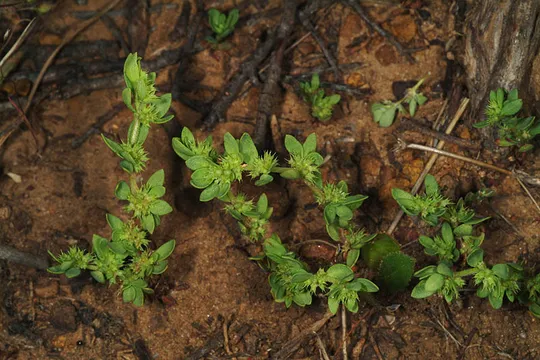Trembling Sandwort
Arenaria tremula
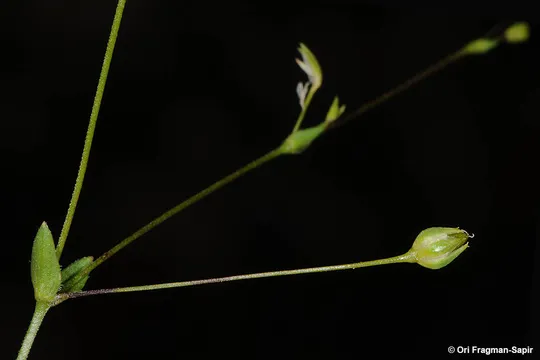
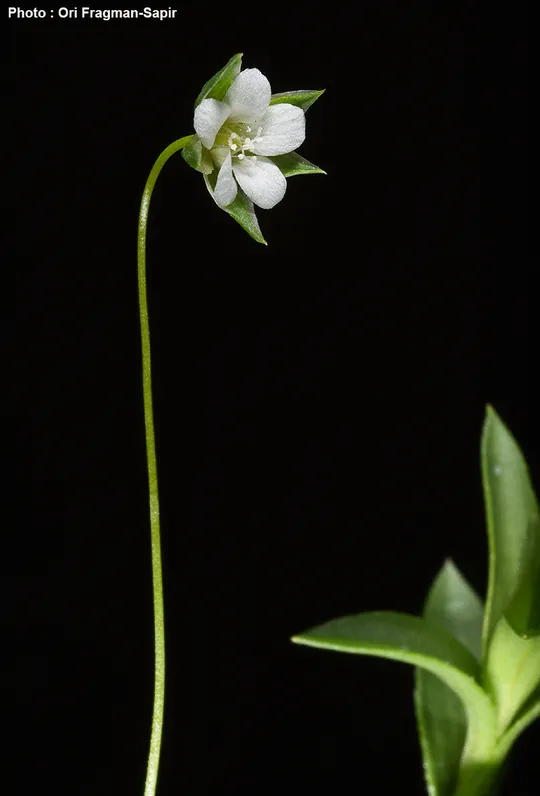
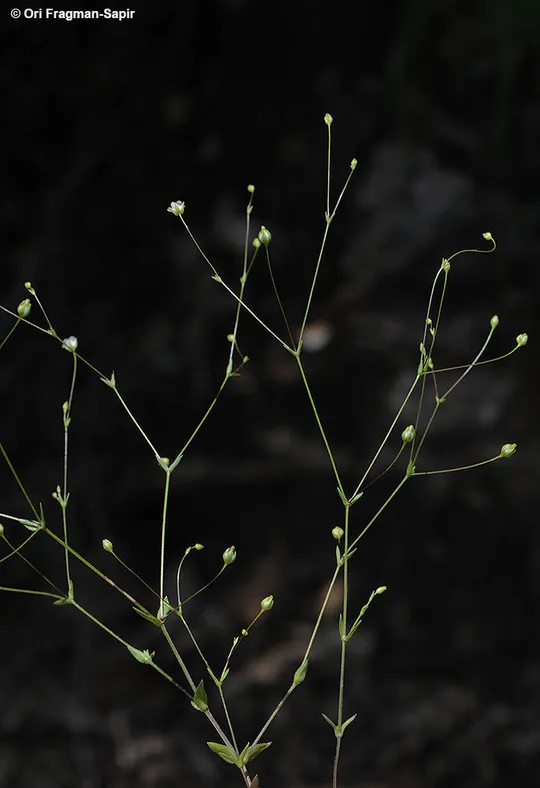
Arenaria tremula is a delicate herbaceous annual, upright or decumbent, 12-25 cm tall. It has many green to reddish-brown stems. The upper section of the stems branches dichotomously and each branch has a few flowers at its end. The leaves are sessile, alternate, linear, narrow and elongated. Thin veins protrude along the leaves. A. tremula has particularly long pedicels – 2-3 cm long and very thin. The five sepals are hairless, about 3 mm long, with a white papery edge and three prominent veins along them. The five entire oval white petals are a little shorter than the sepals. The capsule is oval, 4 mm long; it protrudes from the calyx and opens in six valves upon ripening. There are numerous tiny seeds. A. tremula blooms in the second half of April.
Arenaria tremula grows only in the Upper Galilee in the Mount Meron block, in a few sites: the Mount Meron peak, Wadi Afa'im, En HaZaken, Mount Hillel, Mount Peki’in, Mount Zeved, Mount Shfanim and the Kfir mountaintop. Eig first found the species in Israel in 1925 on Mount Meron.
Forest edges, herbaceous clearings or scrubland, in the partial shade of trees in moist woods on mountains above an altitude of 700 m. The species is associated with freshly disturbed habitats in the Mount Meron area. It is found mainly on roadsides, at the edges of cultivated areas, mole mounds, unstable soil, and in locations where the forest was recently burned.
The genus Arenaria has about 250 species, mostly perennial and annual herbs, and a few dwarf shrubs. The species in the genus are found in many regions of the world, particularly in the northern hemisphere. The genus belongs to the family Caryophyllaceae, which in Israel includes the genera: Minuartia, Arenaria, Stellaria, Bufonia, Holosteum, Cerastium, and Sagina. Most of these are small, delicate and inconspicuous plants, with minute white or pink flowers.
Arenaria is closely related to the genus Minuartia, and is very similar to it. Arenaria tremula is very similar to Minuartia hybrida, which grows in the same locations and in the same habitats. However, all the Minuartia species growing in Israel have veined needle leaves, unlike the relatively broad leaves of Arenaria. Also in Arenaria the head of the open capsule has many teeth (usually 6), unlike the capsule of Minuartia, which opens in three simple valves.
• The population size of Arenaria tremula has not change since it was counted in 1991. The number of plants in the entire Mount Meron region is estimated at between 500- 2000. However, road construction, agricultural development and pesticide and fertilizer use pose a threat Arenaria habitat.
• Only some 5 to 30 individuals were counted at most of the sites where Arenaria tremula was found in 1991. At the Mount Zeved and Mount Hillel sites, 100 to 250 plants were counted, and therefore this is where the main conservation site should be located.
• All the Arenaria tremula populations are grouped in one geographical area. The maximum distance between two sites is 8 km, but there is great geographic fragmentation between the Mount Meron and the Lebanese populations.
• The species produces seeds successfully and many of the seeds are dispersed near the mother plants.
The Arenaria tremula populations on Mount Zeved and Mount Hillel should be monitored. Because all the populations grow in open areas, management should ensure that open spaces are preserved at the sites where the species grows. Closing the area to grazing and logging could reduce the number of habitats. As the number of individuals in Israel is low, cultivated seeds should be germinated in refuge gardens to reinforce existing populations.
Arenaria tremula is endemic, and its range extends from southern Turkey to northern Israel: from the Amanus and Taurus Mountains in southern Turkey through the Mediterranean parts of Syria and Lebanon to the Upper Galilee. It is not found on Mount Hermon.
Arenaria tremula is a delicate annual herbaceous plant that grows only in the Mount Meron area in Israel. As a northern peripheral, it is endangered due to the small number of sites on which it grows, its small populations and its limited global distribution, and has therefore been included in the list of the red plants. Although all its locations are included in the Mount Meron Nature Reserve, development and expansion of farming areas endanger its existence.
Current Occupancy Map
| 1000 squre meter pixel | 5000 squre meter pixel | 10000 squre meter pixel | |
|---|---|---|---|
| number of observations | 0 | 0 | 0 |
| in total pixels | 0 | 0 | 0 |
| Family | Caryophyllaceae |
| Classification | On the endangered species list |
| Ecosystem | Mediterranean |
| Chorotype | Eastern Mediterranean |
| Conservation Site | Mount Zeved , Mount Hillel |
| Rarity |
1
3
6
|
|---|---|
| Vulnerability |
0
0
4
|
| Attractiveness |
0
0
4
|
| Endemism |
0
2
4
|
| Red number |
1
3.7
10
|
| Peripherality | N |
| IUCN category | DD EW EX LC CR EN VU NT |
| Threat Definition according to the red book | Vulnerable |
 Based on:
Based on:
